Monthly Archives: May 2020
 As World War II was winding down, and it was becoming abundantly clear that Nazi Germany was not going to win, the “brave” leaders of the Third Reich began to make plans to run out on their Army, leaving them to take the fall alone. The Nazi leaders were given aliases, and plans were made to get them to Argentina, a country known for its lax immigration policies. The Nazis planned to regroup in Argentina and try for world domination again at a later date.
As World War II was winding down, and it was becoming abundantly clear that Nazi Germany was not going to win, the “brave” leaders of the Third Reich began to make plans to run out on their Army, leaving them to take the fall alone. The Nazi leaders were given aliases, and plans were made to get them to Argentina, a country known for its lax immigration policies. The Nazis planned to regroup in Argentina and try for world domination again at a later date.
Hitler’s hatred for Jews, like any racism was not logical. The Jewish people had done nothing to Hitler or any other German person. This was just a sick personal idea of Hitler’s. It comes from an intolerance to the differences that are naturally occurring in humans, and why would we want to all look the same anyway. It makes no sense at all. Different people have different things to contribute to any society, but Hitler could only see his own twisted idea of a perfect person…odd, when you consider the fact that Hitler would not have fit into his own mold of “perfect” at all. Hitler had a number of conditions that would have, by his own standards, have precipitated his death by the very people who enforced Hitler’s laws.
The man Hitler put in charge of his “final solution of the Jewish question,” Adolf Eichmann, was a man who’s racism and evil personality were quite likely equal to Hitler’s. I have no idea how anyone could plan the murder  of millions of people, of any race, without that person being evil itself. Eichmann was just that. He knew what he was doing, and he relished the idea of “being a god” over those people’s lives…choosing who lives and who dies. Most of us dislike jury duty, because we don’t want to make such decisions for fellow citizens, but Eichmann loved it…thrived on it.
of millions of people, of any race, without that person being evil itself. Eichmann was just that. He knew what he was doing, and he relished the idea of “being a god” over those people’s lives…choosing who lives and who dies. Most of us dislike jury duty, because we don’t want to make such decisions for fellow citizens, but Eichmann loved it…thrived on it.
Eichmann was born in Solingen, Germany, in 1906. Eichmann joined the Nazi’s elite SS (Schutzstaffel) organization in November 1932. The members of the SS came to have broad responsibilities in Nazi Germany, including policing, intelligence, and the enforcement of Adolf Hitler’s anti-Semitic policies. Eichmann was good at his job, and steadily rose in the SS hierarchy. When the Nazis annexed Austria in 1938, Eichmann was sent to Vienna, His mission…rid the city of Jews. He set up an efficient Jewish deportment center and in 1939 was sent to Prague on a similar mission. That year, Eichmann was appointed to the Jewish section of the SS central security office in Berlin. I don’t know how he could have looked himself in the mirror.
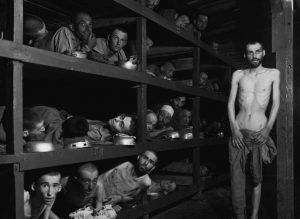 After the war, Eichmann was captured by US troops. Somehow, he managed to escape from the prison camp in 1946, before the Nuremberg International War Crimes Tribunal. Taking an assumed identity, Eichmann traveled between Europe and the Middle East. Finally, in 1950 Eichmann arrived in Argentina. In 1957, a German prosecutor secretly informed Israel that Eichmann was living in Argentina. Time had not forgiven the crimes Eichmann had committed. Agents from the Mossad, Israel’s intelligence service, were deployed to Argentina, and in early 1960 they finally located Eichmann. He was living in the San Fernando section of Buenos Aires under the name of Ricardo Klement. He was taken back to Israel, and on May 31, 1962, he was finally hanged for his horrific crimes against humanity.
After the war, Eichmann was captured by US troops. Somehow, he managed to escape from the prison camp in 1946, before the Nuremberg International War Crimes Tribunal. Taking an assumed identity, Eichmann traveled between Europe and the Middle East. Finally, in 1950 Eichmann arrived in Argentina. In 1957, a German prosecutor secretly informed Israel that Eichmann was living in Argentina. Time had not forgiven the crimes Eichmann had committed. Agents from the Mossad, Israel’s intelligence service, were deployed to Argentina, and in early 1960 they finally located Eichmann. He was living in the San Fernando section of Buenos Aires under the name of Ricardo Klement. He was taken back to Israel, and on May 31, 1962, he was finally hanged for his horrific crimes against humanity.

 My great grand nephew, Jaxx Harman is the youngest on my grand nephew Jake Harman and his wife Melanie’s three children. Jaxx is their only son, and having two older sisters can be awesome, or it can be a fight. Thankfully for Jaxx, he has great sisters. While there are those minor disagreements that all siblings have, they are pretty great to have around. For most of his life, his older sisters have been showing him the ropes of life, but Jaxx is getting to be a big boy now, and his own attitude is starting to present itself into the family picture. A boy with two older sisters has to get a handle on things before he gets too old, or they girls will push him around.
My great grand nephew, Jaxx Harman is the youngest on my grand nephew Jake Harman and his wife Melanie’s three children. Jaxx is their only son, and having two older sisters can be awesome, or it can be a fight. Thankfully for Jaxx, he has great sisters. While there are those minor disagreements that all siblings have, they are pretty great to have around. For most of his life, his older sisters have been showing him the ropes of life, but Jaxx is getting to be a big boy now, and his own attitude is starting to present itself into the family picture. A boy with two older sisters has to get a handle on things before he gets too old, or they girls will push him around.

Jaxx can’t have that. At the grown up age of three, he has to start asserting himself…or at least that’s what he has decided. Jaxx is all boy, and like many boys, he loves to wrestle, fight, and in general, be ornery. According to his mom is a little monkey. I can totally picture that too. From jumping on the bed…when Mommy isn’t looking, to climbing on every thing he can think of. It’s every “boy-mom’s” stressor. Still, when Jaxx looks at his mommy, her heart just melts too, because he is, after all, her boy and she loves him!! While Jaxx is ornery, he still is just so sweet too. It’s all part of his charm.
Jaxx loves his sisters, but he is the brother, and brothers must tease sisters. I think that is an unspoken rule!! His favorite argument with his sisters is, “Who is Daddy’s Favorite!!” Of course, his daddy loves each of his children equally, but it’s a fun argument to have, and Jaxx is just figuring that out. Jaxx may be the youngest child, but he can still give his sisters a “run for their money” when it comes to a fight. His sister Izabella fights and wrestles back, but his oldest sister, Alice takes it pretty easy 
 on him. I’m sure she worries about hurting him. That could change as he gets older, and bigger.
on him. I’m sure she worries about hurting him. That could change as he gets older, and bigger.
Jaxx is learning about manners and etiquette. He is very careful to follow some basic rules. If someone sneezes, Jaxx is quick to say, “Bless you.” He is learning things like please, thank you, and excuse me too. One of the very sweetest aspects of his personality, is that Jaxx loves to pray at bedtime and before eating. His little spirit loves God so much, and he wants to know more about Him. His parents are active in their church, and Jaxx wants to be just like them. He has good role models to follow after all. Today is Jaxx’s 3rd birthday. Happy birthday Jaxx!! Have a great day!! We love you!!
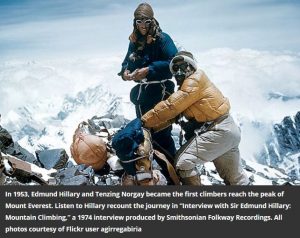 The news of June 2, 1953 was of Queen Elizabeth II’s coronation, but also of the hailed “good omen” for their country’s future…in reference to the first explorers to reach the summit of Mount Everest, which at 29,035 feet above sea level is the highest point on earth. The landmark assent to the top of the world culminated at 11:30am on May 29, 1953 when Edmund Hillary of New Zealand and Tenzing Norgay, a Sherpa of Nepal, made their final assault on the summit after spending a fitful night at 27,900 feet.
The news of June 2, 1953 was of Queen Elizabeth II’s coronation, but also of the hailed “good omen” for their country’s future…in reference to the first explorers to reach the summit of Mount Everest, which at 29,035 feet above sea level is the highest point on earth. The landmark assent to the top of the world culminated at 11:30am on May 29, 1953 when Edmund Hillary of New Zealand and Tenzing Norgay, a Sherpa of Nepal, made their final assault on the summit after spending a fitful night at 27,900 feet.
While the first summit of Mount Everest was an epic accomplishment, it was the words “fitful night” that drew my attention the most. I recently finished a novel by Harry Farthing called “Summit.” While his book was a novel, much of it was based on, if not actual events, actual conditions on the mountain. I am a hiker, and I like hiking to the highest mountains in an area, but let it be known that I am not a mountain climber, and I have no desire to hike through treacherous snow storms to reach the victory of the summit. Nevertheless, many people are obsessed with getting to the world’s highest peaks. Such was the case with Hillary and Norgay. They were determined to make it. I have no idea how prepared they were, but since their victory, and quite possibly before it too, there have been those who misjudged the mountain, the storms, and their own abilities…to their detriment.
While listening to “Summit,” I found myself cheering on the climbers, but also feeling the depths of the many defeats along the way. The biggest necessity on the mountain, is oxygen. At the base camp of Mount Everest, which is 17,500 feet, the air contains 50% of oxygen levels at sea level. At that level, without oxygen, people feel tired and light-headed and develop a headache. They might feel nauseous and even begin to vomit up everything they eat, and then just dry heave themselves to exhaustion. Of course, having oxygen tanks can change this situation into one that is manageable for survival. And that is just at the base camp, which is almost 12,000 feet below the summit. Between Camp 1, at 20,000 feet, and Camp 3, at 24,000 the oxygen levels drop to below 40%. At this point you are prone to hallucinate. Your whole body hurts. You can’t eat, sleep, and most people find breathing next to impossible. From here you operate on sheer willpower. You put one foot in front of the other, and keep moving, because if you do not, you will die. As you near the summit, at 29,035 feet, the air has less that one-third of the sea level oxygen, and can drop as low as 14%…a low level that was recorded in 1996. Twenty climbers lost their fight with the mountain, and their lives, that year. At this point, you should for all intents and purposes be dead. If you are still going, you are probably one of just a few people. On May 8, 1978, Reinhold Messner and Peter Habeler reached the summit of Mount Everest. They were the first men known to climb it without the use of supplemental oxygen. Two years later, on August 20, 1980, Messner again stood atop the highest mountain in the world, without supplementary oxygen. Cory Richards and Adrian Ballinger also summited the highest mountain in the world in 2017…Ballinger without supplemental oxygen. I don’t know how they did it. Those who have failed to make it to the summit, with or without oxygen, have said that they now know what dying feels like. I’m sure that doesn’t apply to all kinds of death, but certainly death on Mount Everest or any of the other mountains that are nearly as tall, it is like this. The symptoms of death by oxygen depravation quickly take their toll on the body. In the minutes before death, the pain must be excruciating. And then, still before death arrives, the body gives up, and feels no more. The  people that die on Everest are left on Everest. They climbers that go up, pass them along the way. It is a grim reminder that if you are not prepared, you might not be coming down.
people that die on Everest are left on Everest. They climbers that go up, pass them along the way. It is a grim reminder that if you are not prepared, you might not be coming down.
Mount Everest sits on the crest of the Great Himalayas in Asia, lying on the border between Nepal and Tibet. Called Chomo-Lungma, or “Mother Goddess of the Land,” by the Tibetans, the English named the mountain after Sir George Everest, a 19th-century British surveyor of South Asia. It is a majestic mountain, and one I might enjoy seeing…from an airplane…but it is not one that I would ever choose to climb, even though I love to hike. Nevertheless, you can’t help be to be in awe of those who would climb the mountain and receive that treacherous victory.
 Every security detail prides itself in being able to stop any attack that might come toward the person or persons they are assigned to protect. Allowing a threat, any threat…be it a serious threat, or a minor prank…to get by the security check points, is seriously embarrassing and can be very dangerous. Never was this more widely publicized than on May 28, 1987, in Moscow.
Every security detail prides itself in being able to stop any attack that might come toward the person or persons they are assigned to protect. Allowing a threat, any threat…be it a serious threat, or a minor prank…to get by the security check points, is seriously embarrassing and can be very dangerous. Never was this more widely publicized than on May 28, 1987, in Moscow.
Early on that morning, a young man named Matthias Rust, a 19 year old amateur pilot from West Germany, took off from Helsinki, Finland and headed east. Rust flew his small Cessna airplane through 400 miles of Soviet airspace, somehow undetected, and landed it in Red Square by the Kremlin. The stunt was an immense embarrassment to the Soviet government and military…to say the least. I would think that “heads would roll” figuratively speaking. Red Square should be some of the most seriously protected airspace in the world, but here a 19 year old kid blew through the protections they had in place, and brazenly landed his small plane right in the middle of Red Square!!

Rust was not a known troublemaker. His mother said that he was a “quiet young man with a passion for flying.” He had no known political or social agenda when he took off from the international airport in Helsinki and headed for Moscow, so what was the purpose of his flight and subsequent illegal landing. He entered Soviet airspace, but was either undetected or ignored as he pushed farther and farther into the Soviet Union, but how was that possible. He arrived over Moscow, early that morning, circled Red Square a few times, and then simply landed…just a few hundred yards from the Kremlin. The people in the square, mostly curious onlookers and tourists, believed that Rust was part of an air show. They quickly surrounded him, probably wanting his autograph. Then, very quickly, Rust was arrested and taken to jail. The charges were severe. He was tried for violating Soviet airspace and sentenced to prison. I don’t know if the charge would have normally gained him a longer prison sentence, or if they took pity on him because of his age, but Rust served 18 months before being released…probably a relatively short sentence in retrospect.
The repercussions in the Soviet Union, however, were immediate. Soviet leader Mikhail Gorbachev fired his minister of defense, and the entire Russian military was humiliated by Rust’s flight into Moscow. The United 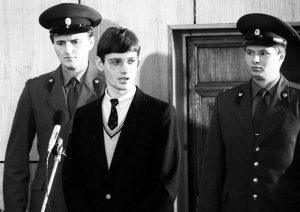 States officials didn’t make matters any easier either. They had a field day with the event. One American diplomat in the Soviet Union joked, “Maybe we should build a bunch of Cessnas.” The Soviet officials were not amused. Just four years earlier, the Soviets had been harshly criticized for shooting down a Korean Airlines passenger jet that veered into Russian airspace. Now, being able to stop one teenager’s “invasion” of the country, the Soviets became the laughingstocks. One Russian spokesperson bluntly declared, “You criticize us for shooting down a plane, and now you criticize us for not shooting down a plane.” No matter how you look at it, the situation was, to say the least, militarily embarrassing.
States officials didn’t make matters any easier either. They had a field day with the event. One American diplomat in the Soviet Union joked, “Maybe we should build a bunch of Cessnas.” The Soviet officials were not amused. Just four years earlier, the Soviets had been harshly criticized for shooting down a Korean Airlines passenger jet that veered into Russian airspace. Now, being able to stop one teenager’s “invasion” of the country, the Soviets became the laughingstocks. One Russian spokesperson bluntly declared, “You criticize us for shooting down a plane, and now you criticize us for not shooting down a plane.” No matter how you look at it, the situation was, to say the least, militarily embarrassing.

 It’s a strange thing to have something you have expected to last for a certain period of time, come to an abrupt end. You find yourself hanging in limbo, and it can become depressing, or I suppose it could become exhilarating, if it was something you didn’t really like anyway. Such has been the case with the 2020 school year, and the Covid-19 Pandemic that changed everything. Yes, the students are still in class, at least virtual class, but it really isn’t the same. I understand about homeschooling, but for parents who did not expect to make that commitment, it can be a daunting task. There is more to it than just the classwork too. Kids need structure, and having summer begin at Spring Break threw everyone into a tailspin. At first it just seemed like a really long Spring Break, then when the virtual classes started, they really started to miss the time spent with their friends and their teachers…even the tough ones. It seems that being in class with a teacher who makes you work for your grade, is preferable to being at home with your parents acting as your teacher, and you are in detention, even if you did nothing wrong.
It’s a strange thing to have something you have expected to last for a certain period of time, come to an abrupt end. You find yourself hanging in limbo, and it can become depressing, or I suppose it could become exhilarating, if it was something you didn’t really like anyway. Such has been the case with the 2020 school year, and the Covid-19 Pandemic that changed everything. Yes, the students are still in class, at least virtual class, but it really isn’t the same. I understand about homeschooling, but for parents who did not expect to make that commitment, it can be a daunting task. There is more to it than just the classwork too. Kids need structure, and having summer begin at Spring Break threw everyone into a tailspin. At first it just seemed like a really long Spring Break, then when the virtual classes started, they really started to miss the time spent with their friends and their teachers…even the tough ones. It seems that being in class with a teacher who makes you work for your grade, is preferable to being at home with your parents acting as your teacher, and you are in detention, even if you did nothing wrong.
At first, when it was just the extended Spring Break, and people were staying at home, no one really noticed that he kids were out of school. Then, as the weather got warmer, people got out on the trails and on the playgrounds, still “social distancing,” but getting a little bit of fresh air and removing themselves from the “cabin fever” that was quickly threatening their sanity. Suddenly, we became very aware that these kids should be in school. While the weather was warmer, it wasn’t summer yet. The school year of 2020 had only officially run for seven of the nine months it was supposed to. In fact, truth be told, school should still be in session…even now. And yet, while summer vacation is not here yet, the schools are closed. The 2020 school year hasn’t officially ended, and it isn’t officially in progress either. Parents are worried about the education their kids got this last quarter. Virtual classes were shorter that normal, and so the kids spent far less time in virtual class too. Nothing about the last quarter of school was normal. The kids didn’t always get to class, but did the homework, thinking it was enough, and for some of them, maybe it was, but what of the rest of them…the ones who needed that class time. Were they left hanging…time will tell, I guess.
The next school year is still up in the air too. There are schools who have said that they will open, and others who will continue the virtual program. That has parents up in arms too, because they are preparing to go back to work, and they will need someone to be home with their children while they work. A virtual teacher doesn’t really replace the safety of being in the classroom with a teacher in charge. All the “experts” have said that life is going to take on a “new normal,” and they may be right, but I think that if school doesn’t start back up next 
 school year, there will be a lot of parents who might need to start taking Prozac or something similar. Most parents find themselves impatiently awaiting the end of summer so the kids can go back to school, but this year was like the summer that never ended. The kids are just as bored, and there was no place to send them. The pools aren’t going to open, the rec centers either, and there is only so much a kid can do at the school playground. The walking paths are frequented by kids on bicycles and longboards, and even kids walking their dogs, but the reality is, these kids need to go back to school. They are designed to be social beings, not socially distanced.
school year, there will be a lot of parents who might need to start taking Prozac or something similar. Most parents find themselves impatiently awaiting the end of summer so the kids can go back to school, but this year was like the summer that never ended. The kids are just as bored, and there was no place to send them. The pools aren’t going to open, the rec centers either, and there is only so much a kid can do at the school playground. The walking paths are frequented by kids on bicycles and longboards, and even kids walking their dogs, but the reality is, these kids need to go back to school. They are designed to be social beings, not socially distanced.
 World War II was one time when the United States and Germany were absolutely not friends. The Nazi beliefs and the American beliefs were worlds apart. Nevertheless, not all Germans were Nazis, and hard to believe as that may be, it was true. Never was that more evident that at Castle Itter, a small fortification in Austria used by the SS during World War II as a prison for high profile detainees. On May 6, 1945, with the Third Reich collapsing against the Allied attacks, the German commander of Dachau, Wilhelm Weiter committed suicide. At that point, some of the Waffen SS soldiers retreated, and amid the chaos that followed, the opportunity presented itself, and a Yugoslav freedom fighter, Zvonimir Cuckovic, who was a prisoner at Dachau, escaped and went looking for some Allied troops to rescue the rest of the prisoners.
World War II was one time when the United States and Germany were absolutely not friends. The Nazi beliefs and the American beliefs were worlds apart. Nevertheless, not all Germans were Nazis, and hard to believe as that may be, it was true. Never was that more evident that at Castle Itter, a small fortification in Austria used by the SS during World War II as a prison for high profile detainees. On May 6, 1945, with the Third Reich collapsing against the Allied attacks, the German commander of Dachau, Wilhelm Weiter committed suicide. At that point, some of the Waffen SS soldiers retreated, and amid the chaos that followed, the opportunity presented itself, and a Yugoslav freedom fighter, Zvonimir Cuckovic, who was a prisoner at Dachau, escaped and went looking for some Allied troops to rescue the rest of the prisoners.
Hans Fuchs, who was a young student going to school nearby, remembers how Itter Castle was converted into a prison by the Nazis in 1943. He said, “We saw everything from our school window, a double barbed-wire fence…and floodlights so that the whole night was lit up like day.” Itter Castle, is an old castle, dating back to the Middle Ages. It was turned into a sub-unit of the Dachau concentration camp, and used for VIP prisoners, prominent politicians, and military figures that the Nazis wanted to use as bargaining chips. Famous prisoners  there included two former prime ministers of France, Edouard Daladier and Paul Reynaud, as well as the elder sister of Gen Charles de Gaulle, Marie-Agnes Cailliau.
there included two former prime ministers of France, Edouard Daladier and Paul Reynaud, as well as the elder sister of Gen Charles de Gaulle, Marie-Agnes Cailliau.
Cuckovic’s escape triggered one of the most curious battles of the conflict, but not in the way you might think. After he escaped, Cuckovic found an American armored column and got them to come with him. At the same time a Major Josef Gangl, who was an Austrian in the German Army, and had been collaborating with Austrian resistance in the closing days of the war, also intended to free the castle prisoners, but had decided instead to surrender with his men to the Americans. Gangl hated what was going on and knew that the Nazis were friends to no one. He could no longer stomach what he had been commanded to do. With the arrival of Cuckovic a hasty agreement took place. The major and his Wehrmacht troops would fight alongside the Americans against the SS guards.
The resulting battle of Castle Itter was not a major battle, just an amazing one. The SS faced not only their own countrymen and Americans, complete with a Sherman tank, but there were also Austrian partisans and French prisoners joining in. It was a wonderful show of the unifying effect the Allies had compared to the polarizing effect of the Nazis. The ensuing battle was not big, and in fact, a maximum of just 100 men were 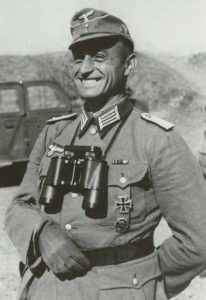 involved. Nevertheless, this battle was, without a doubt, vicious. The Sherman tank was destroyed and Major Josef Gangl was killed by a sniper. The thing that made this battle so unique, however, was that it was the only time the American army fought alongside the German army in all of World War II. The SS were handily defeated and quickly surrendered. The rest of the prisoners held at Castle Itter were released unharmed.
involved. Nevertheless, this battle was, without a doubt, vicious. The Sherman tank was destroyed and Major Josef Gangl was killed by a sniper. The thing that made this battle so unique, however, was that it was the only time the American army fought alongside the German army in all of World War II. The SS were handily defeated and quickly surrendered. The rest of the prisoners held at Castle Itter were released unharmed.
There have been times in many wars, when two soldiers made the conscious decision not to engage in battle, allowing both to live to fight another day. I suppose it would not be unheard of to have two opposing soldiers work together to defeat a common enemy, like maybe a bear or other wild animal, but for two army patrols of two opposing sides, to join forces against part of one sides army, is…well, unheard of. The battle at Castle Itter was just such a battle, and it is believed to be the only battle in the war in which Americans and Germans fought as allies.
 My niece, Cassie Iverson is a wife and mother of two children. She is also an activist for the causes she believes in. Most of them are causes for the protection of family and children. Cassie and her husband, Chris lived in a rented house while she was pregnant with their first child, their son, Lucas, who was born with Down Syndrome. They found out that the house had black mold, but the landlord wouldn’t do anything about it. Of course, there are no known ties between black mold and Down Syndrome, but there are many health problems that are associated with black mold. At that time, there seemed no way to get the satisfaction she sought from her landlord, so in the end, they move to a better home.
My niece, Cassie Iverson is a wife and mother of two children. She is also an activist for the causes she believes in. Most of them are causes for the protection of family and children. Cassie and her husband, Chris lived in a rented house while she was pregnant with their first child, their son, Lucas, who was born with Down Syndrome. They found out that the house had black mold, but the landlord wouldn’t do anything about it. Of course, there are no known ties between black mold and Down Syndrome, but there are many health problems that are associated with black mold. At that time, there seemed no way to get the satisfaction she sought from her landlord, so in the end, they move to a better home.
Cassie and Chris have fought through a number of health issued with Lucas, and they are very careful about his treatments. While many people would not agree with them, they are against vaccinations, because they feel that the ingredients in them are more dangerous than the disease the vaccination is trying to prevent. I don’t know which side of the coin my readers are on, and in this case, I have now desire to debate the vaccination issue, but rather I just want to say that it is my belief that each set of parents have the right to make that choice for their children, and that they should feel safe in doing so. I don’t think that anyone should be subject to  verbal attacks because they have differing opinions on this or really, any other of the hot button issues. The best thing about our liberties, is that we have the right to chose what is best for our family. The worst thing about our liberties, is that we risk making other people mad.
verbal attacks because they have differing opinions on this or really, any other of the hot button issues. The best thing about our liberties, is that we have the right to chose what is best for our family. The worst thing about our liberties, is that we risk making other people mad.
Whether you agree or not, we need people who will bring to light the other side of the coin, and that is what Cassie does. That takes courage in the current hostile climate in our nation. We face the same issues concerning the current Covid-19 Pandemic. There are so many views that no one knows what to think. That is why, we all have to make our own choices. Today is Cassie’s birthday. Happy birthday Cassie!! I hope you got to do something fun. Have a great day!! We love you!!
 As baseball looks at getting started again, it seems like a good to talk about the time when Major League Baseball became Little League Baseball. Ok, not exactly, but nevertheless, little league it was to a certain degree. The year was 1951, and the Saint Louis Browns were sporting their smallest player in history…probably in the history of baseball. His name was Edward Carl “Eddie” Gaedel, and he stood just 3 feet 7 inches tall. He weighed 65 pounds. Gaedel was born on June 8, 1925, in Chicago. He was the second of the three children of Carl and Helen Gaedel. Carl Gaedel was born in Lithuania and immigrated to the United States in 1902, settling in Chicago before starting his family. The family name may have been changed to Gaedel from Gaedele at the time of his immigration.
As baseball looks at getting started again, it seems like a good to talk about the time when Major League Baseball became Little League Baseball. Ok, not exactly, but nevertheless, little league it was to a certain degree. The year was 1951, and the Saint Louis Browns were sporting their smallest player in history…probably in the history of baseball. His name was Edward Carl “Eddie” Gaedel, and he stood just 3 feet 7 inches tall. He weighed 65 pounds. Gaedel was born on June 8, 1925, in Chicago. He was the second of the three children of Carl and Helen Gaedel. Carl Gaedel was born in Lithuania and immigrated to the United States in 1902, settling in Chicago before starting his family. The family name may have been changed to Gaedel from Gaedele at the time of his immigration.
Gaedel was the smallest player ever to appear in a Major League Baseball game. He gained recognition in the second game of a Saint Louis Browns doubleheader on August 19, 1951. Gaedel’s major league career was shorter than he was in the end. He made a single plate appearance and was walked with four consecutive balls before being replaced by a pinch-runner at first base. Nevertheless, his jersey, bearing the uniform number “?1?8,” is displayed in the Saint Louis Cardinals Baseball Hall of Fame and Museum. Sometimes, it isn’t the length of the career that matters, But rather it is what makes the career unique that really matters. Never before had the major leagues had such a player. It was like putting a child on the major leagues, except that he could play…at least well enough to be chosen to play on the Saint Louis Browns in the first place. The world will never know if he could have been great, because he only played the one time.
Gaedel was well liked. The Saint Louis Browns owner, Bill Veeck said of Gaedel in his 1962 autobiography said, “He was, by golly, the best darn midget who ever played big-league ball. He was also the only one.” Both statements were true, and Gaedel would go down in history as the midget who combined the Major League with the Little League.
Prior to his career in baseball, and due to his size, Gaedel had worked as a riveter during World War II. He was unique in his job, because he was able to crawl inside the wings of airplanes. He was also a professional performer, belonging to the American Guild of Variety Artists (AGVA). After the war, Gaedel was hired in 1946 by Mercury Records as a mascot to portray the “Mercury Man.” He sported a winged hat similar to the record label’s logo, to promote Mercury recordings. Some of the early Mercury recordings featured a caricature of him as its logo. Then, the Browns’ owner Bill Veeck, who liked a little bit of the outrageous, and a showman who enjoyed staging publicity stunts, found Gaedel through a booking agency. He secretly signed him to the Browns, he was added to the team roster and put in uniform…with the number “?1?8” on the back. The uniform belonged to current Saint Louis Cardinals managing partner and chairman William DeWitt, Jr. who was a 9 year old batboy for the Browns at the time. It may have been a stunt, but it made Eddie Gaedel famous.
Unfortunately, after his baseball career ended, things did not go well for Gaedel. On June 18, 1961, and having just turned 36, an unemployed Gaedel, was at a bowling alley in Chicago. Gaedel was followed home and beaten. His mother discovered Eddie lying dead in his bed. He had bruises about his knees and on the left side of his face. A coroner’s inquest determined that he also had suffered a heart attack. Bob Cain, who’d pitched to 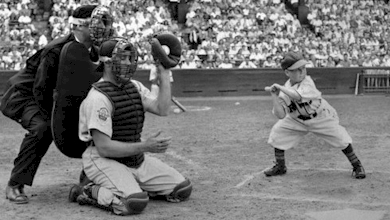 Gaedel, was the only Major League Baseball figure to attend the funeral. Gaedel was buried at Saint Mary Catholic Cemetery and Mausoleum in Cook County, Illinois. His tombstone indicates that his family name may actually have been Gaedele, not Gaedel. The person or persons who killed Gaedel were never found. The police speculated that Gaedel, who had become known as a hot-head, probably got into an argument with someone at the bowling alley, and the person followed him and beat him. Because of Gaedel’s reputation, the Chicago Police Department declined to investigate the matter further. It was such a tragic end for a Baseball Hall of Famer.
Gaedel, was the only Major League Baseball figure to attend the funeral. Gaedel was buried at Saint Mary Catholic Cemetery and Mausoleum in Cook County, Illinois. His tombstone indicates that his family name may actually have been Gaedele, not Gaedel. The person or persons who killed Gaedel were never found. The police speculated that Gaedel, who had become known as a hot-head, probably got into an argument with someone at the bowling alley, and the person followed him and beat him. Because of Gaedel’s reputation, the Chicago Police Department declined to investigate the matter further. It was such a tragic end for a Baseball Hall of Famer.
 As New York City grew is size, passing Paris in population and quickly catching up to London by the late 19th century too, it still remained the only city of such size to lack a public library large enough to serve it’s many citizens. It didn’t look like something that was going to change in the near future, but when former New York Governor Samuel J. Tilden died in 1886, he left $2.4 million to the city to “establish and maintain a free library and reading room in the city of New York.”
As New York City grew is size, passing Paris in population and quickly catching up to London by the late 19th century too, it still remained the only city of such size to lack a public library large enough to serve it’s many citizens. It didn’t look like something that was going to change in the near future, but when former New York Governor Samuel J. Tilden died in 1886, he left $2.4 million to the city to “establish and maintain a free library and reading room in the city of New York.”
While it was a wonderful gift, it remain unspent until May 23, 1895, when New York’s two largest libraries…the Astor and Lenox libraries…agreed to combine with the Tilden Trust to form a new entity that would be known as The New York Public Library. I’m not sure why the delay, other than maybe the loss of some of the smaller  “neighborhood” libraries. Whatever the case may be, the work finally began on the New York Public Library, and the final structure was spectacular.
“neighborhood” libraries. Whatever the case may be, the work finally began on the New York Public Library, and the final structure was spectacular.
The main branch of the library was dedicated in midtown Manhattan sixteen years later to the day. The library is the largest marble structure ever constructed in the United States, is dedicated in New York City. I don’t know much about construction, but it seems to me that marble construction might be harder. The building fills a two-block section of Fifth Avenue between 40th and 42nd Streets, the monumental structure took 14 years to complete at a cost of $9 million. Nevertheless, the day after its dedication, the library opened its doors to the public, and some 40,000 citizens passed through to make use of a collection that already consisted of more than a million books. The people of New York City were excited to have such a wonderful collection of  knowledge at their disposal…and for free. In a ceremony presided over by President William Howard Taft, the New York Public Library was dedicated on May 23, 1911. Gifts continues to roll in over the next few decades, and thanks in large part to a $5.2 million gift from steel baron Andrew Carnegie, a system of branch libraries opened throughout New York City, basically giving back some of the neighborhood library feel again. Today, the New York Public Library is visited and used annually by more than 10 million people, and there are currently well over two million cardholders, more than for any other library system in the nation.
knowledge at their disposal…and for free. In a ceremony presided over by President William Howard Taft, the New York Public Library was dedicated on May 23, 1911. Gifts continues to roll in over the next few decades, and thanks in large part to a $5.2 million gift from steel baron Andrew Carnegie, a system of branch libraries opened throughout New York City, basically giving back some of the neighborhood library feel again. Today, the New York Public Library is visited and used annually by more than 10 million people, and there are currently well over two million cardholders, more than for any other library system in the nation.

 My grand nephew, Xander Spethman like most kids this year, had a challenging school year. He had never planned to be homeschooled. He was used to having his friends around him and all the activities at school. He was used to some level of independence that going to high school offered. Then, suddenly he was at home with his siblings. His parents were often at work, so that also left Xander in charge sometimes. In many kids Xander’s age, that many hours with the younger siblings might have made life miserable for all concerned, but Xander is a kind-hearted young man. He loves his siblings, and they look up to him. Xander tried to be a lead-by-example kind of person. That makes for a much more harmonious household, whether the parents are there or not.
My grand nephew, Xander Spethman like most kids this year, had a challenging school year. He had never planned to be homeschooled. He was used to having his friends around him and all the activities at school. He was used to some level of independence that going to high school offered. Then, suddenly he was at home with his siblings. His parents were often at work, so that also left Xander in charge sometimes. In many kids Xander’s age, that many hours with the younger siblings might have made life miserable for all concerned, but Xander is a kind-hearted young man. He loves his siblings, and they look up to him. Xander tried to be a lead-by-example kind of person. That makes for a much more harmonious household, whether the parents are there or not.
Xander and his brother, Zack have become best friends. They share a love of long boarding, and now they go  as often as they can. He is also sweet to his other siblings, Isaac, and little Aleesia, who thinks her brothers “hung the moon,” a fact that is obvious by the way she looks at them. Xander is a very loyal person. He is also protective of his family. He is an amazing big brother, who always takes time to help with whatever his little brothers and sister need. Xander has demonstrated many leader qualities, that have been beneficial to his siblings and his friends alike. Xander’s mom, Jenny attributes those attributes to being the oldest child, but I disagree. Being the oldest doesn’t guarantee leadership. Those leadership qualities come from several sources, not the least of which is good parental upbringing. It also comes from something inside a person that says, “This is the right thing to do, and that is not.” It is about being settled in the right things to do, and it’s having a determination to do what is right, even if it is the harder road. Xander has that determination, and his family has become the beneficiary of those good leadership qualities. They are very proud of him.
as often as they can. He is also sweet to his other siblings, Isaac, and little Aleesia, who thinks her brothers “hung the moon,” a fact that is obvious by the way she looks at them. Xander is a very loyal person. He is also protective of his family. He is an amazing big brother, who always takes time to help with whatever his little brothers and sister need. Xander has demonstrated many leader qualities, that have been beneficial to his siblings and his friends alike. Xander’s mom, Jenny attributes those attributes to being the oldest child, but I disagree. Being the oldest doesn’t guarantee leadership. Those leadership qualities come from several sources, not the least of which is good parental upbringing. It also comes from something inside a person that says, “This is the right thing to do, and that is not.” It is about being settled in the right things to do, and it’s having a determination to do what is right, even if it is the harder road. Xander has that determination, and his family has become the beneficiary of those good leadership qualities. They are very proud of him.
Xander is a very good example not only to his family, but also to his friends. The leadership qualities Xander 
 displays to his friends, cause many of them to seek him out when they need advise. Unlike many situations where kids are advising kids, which can be catastrophic in their misguided advise, Xander is a very good counselor to his friends. He has a strong sense of right and wrong, and doesn’t like it when he sees anyone being mistreated…a very important quality in a time when “bullying” has become the norm in schools. He always helps anyone who asks and tries to look out for everyone. That is the kind of friend, and brother, everyone is proud to know. Today is Xander’s 17th birthday. Happy birthday Xander!! Have a great day!! We love you!!
displays to his friends, cause many of them to seek him out when they need advise. Unlike many situations where kids are advising kids, which can be catastrophic in their misguided advise, Xander is a very good counselor to his friends. He has a strong sense of right and wrong, and doesn’t like it when he sees anyone being mistreated…a very important quality in a time when “bullying” has become the norm in schools. He always helps anyone who asks and tries to look out for everyone. That is the kind of friend, and brother, everyone is proud to know. Today is Xander’s 17th birthday. Happy birthday Xander!! Have a great day!! We love you!!

